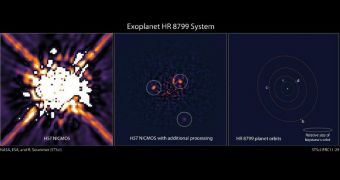Over the course of more than 20 years of observations, the NASA/ESA Hubble Space Telescope has collected a volume of data that is incomparable to any other, in terms of scope, diversity and detail. While browsing through these data, experts recently found two new exoplanets,
The discovery indicates a potential new application for the old datasets, which have thus far been used only as cross-references, by experts studying stars. The entry points contained within can show how much a star or a planetary nebula has evolved over time.
But not many astronomers considered using these information to search for extrasolar planets. The research team that carried out the new study used data collected by the Near Infrared Camera and Multi-Object Spectrometer (NICMOS) instrument in 2008.
Led by Remi Soummer, a research scientist at the Space Telescope Science Institute (STScI), in Baltimore, Maryland, the investigators used modern data mining techniques, that were unavailable at the time when the original observations were made.
This allowed the team to find two more exoplanets in an HR 8799 star system already known to house such objects. The central star is located about 130 light-years away from the Sun, and three of its companions were detected in 2007 and 2008.
Canadian astronomer Christian Marois, of the National Research Council, used the W.M. Keck Observatory and the Gemini North telescope to make both discoveries. In a reiteration of their work, carried out in 2010, the scientists were able to find a fourth exoplanet.
When Hubble was first trained on this system, its detectors spotted the two outer exoplanets, but failed to detect the faint inner ones, whose glow was being overwhelmed by light from their parent star.
Soummer and his group were able to develop light-enhancement techniques that enable them to eliminate the star's brightness, and also boost the overall contrast of the image. Using this approach, the group was able to see the light signature of the other two objects.
The reason why this is such a remarkable achievement is that the new data provide astronomers studying this system with 10 extra years of data. By cross-referencing Hubble data with newer measurements of the system, astronomers are now able to calculate the planets' trajectories.
“From the Hubble images we can determine the shape of their orbits, which brings insight into the system stability, planet masses and eccentricities, and also the inclination of the system,” Soummer says.
The group now plans to start conducting more investigations into archived information collected by Hubble, in hopes that this may help reveal other exoplanets that escaped initial scrutiny.

 14 DAY TRIAL //
14 DAY TRIAL //